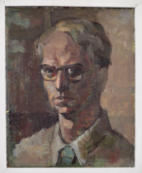All material on this website, including images, text and graphics, is copyright ©2025 by the Vincent Bennett Estate unless otherwise stated. The material
on this site should not be used, copied, stored or transmitted without the prior written consent of the Vincent Bennett Estate in accordance with the
Copyright, Designs and Patents Act 1988. To contact the Vincent Bennett estate, see “Contact” page
Vincent Bennett
1910 - 1993
Written Work
•
Vincent's only illustrated short story has been recently found. Written around the 1950's,
"The Enchanted Cat" has been produced as an eBook. Please click here for further details.
•
“The Great English Novel” the beginnings of his autobiography (unfinished)- available for download - click here for details
Background
Vincent Bennett trained at Plymouth School of Art in the 1920s, alongside Cecil Collins and
moved to London in 1930 where he worked as a scenery painter for a Kensington Studio,
supplementing his income with drawings published in magazines and occasional boxing
matches.
In 1932 he returned to Plymouth and gained local notoriety as a jazz drummer, appearing
regularly at local venues in various ensembles. In 1945 he married Mary Hemingway who
actively encouraged and facilitated his artistic career. Their only child Jonathan was born five
years later, by which time Bennett settled to a more conventional career as an art teacher. He
maintained he learnt more from the children than they did from him.
He retired in 1975, happy to devote himself to painting full time until ill health prevented him.
Style
When Bennett returned to Plymouth from London, he renewed his academic studies at the
local art school and experimented with large-scale work, painting murals in various locations
around the city. Eventually the techniques he used in London as a scenery painter encroached
upon the academic concerns of his formal training and the distinctive Bennett style emerged.
A muted palette and naturalistic forms dominate his early easel painting. In later work, the flat
planes of colour and geometric shapes evolve into a highly textured surface rendered in
Mediterranean hues.
Bennett drew upon an eclectic mix of influences, from Byzantine art to silent cinema, and
whether he tackled grand narratives or studies of the locals in a nearby pub, his work is heavily
impasted with the dry Bennett wit.




Vincent Bennett
1910 - 1993

Background
Vincent Bennett trained at Plymouth School of
Art in the 1920s, alongside Cecil Collins and
moved to London in 1930 where he worked as
a scenery painter for a Kensington Studio,
supplementing his income with drawings
published in magazines and occasional boxing
matches.
In 1932 he returned to Plymouth and gained
local notoriety as a jazz drummer, appearing
regularly at local venues in various ensembles.
In 1945 he married Mary Hemingway who actively encouraged and facilitated
his artistic career. Their only child Jonathan was born five years later, by
which time Bennett settled to a more conventional career as an art teacher.
He maintained he learnt more from the children than they did from him.
He retired in 1975, happy to devote himself to painting full time until ill health
prevented him.
Style
When Bennett returned to Plymouth from
London, he renewed his academic studies at the
local art school and experimented with large-
scale work, painting murals in various locations
around the city. Eventually the techniques he
used in London as a scenery painter encroached
upon the academic concerns of his formal
training and the distinctive Bennett style
emerged.
A muted palette and naturalistic forms dominate
his early easel painting. In later work, the flat
planes of colour and geometric shapes evolve
into a highly textured surface rendered in Mediterranean hues.
Bennett drew upon an eclectic mix of influences, from Byzantine art to silent
cinema, and whether he tackled grand narratives or studies of the locals in a
nearby pub, his work is heavily impasted with the dry Bennett wit.
Written Work
•
Vincent's only illustrated short story has been recently found. Written
around the 1950's, "The Enchanted Cat" has been produced as an
eBook. Please click here for further details.
•
“The Great English Novel” the beginnings of his autobiography
(unfinished)- available for download - click here for details


www.vincent-
bennett.com
Mobile Version
www.vincent-
bennett.com


























































